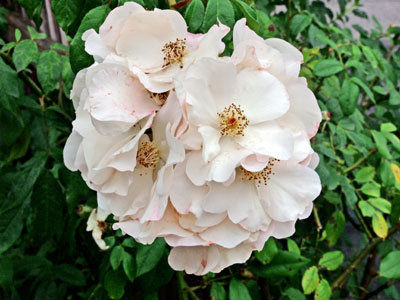
I’m daydreaming about the flowers of spring and summer. What could be more impressive than a big, fragrant, jewel-toned rose? There are some great new ones out this year that I have my eye on. Maybe you have room for one more.
Fragrance is a requirement for me when it comes to roses. The first thing when we admire a beautiful rose is to bend over and smell it. Sure, vase life and petal count are important, but who can resist a fragrant rose? With that in mind, several of the new varieties out this year fit my bill. Consider one of these for your garden.
n Orchid Romance is a small, medium pink-to-lavender floribunda rose. It has a strong citrus aroma on warm days. Grown on its own root, it has good disease resistance and holds up well in a bouquet. Medium-large, very full flower clusters bloom in flushes throughout the season.
n Sugar Moon is an elegant, pure white rose with huge, full, classically formed buds. Saturated with an intensely sweet citrus and rose fragrance, the scent is said to nearly bowl you over. Long cutting stems makes this a perfect addition for the cutting garden. Superior disease resistance is another plus for this new rose.
Time to prune
Cold weather earlier this month has kept roses in the garden dormant, but now is the time to prune them, before they start leafing out, which wastes plant energy.
I want them to produce lots of roses on a compact shrub, not just a few exhibition size, so I prune shrubs moderately. Heirlooms, however, require less pruning, because their open look is part of their charm.
Remember, your goal is to keep the center of the plant open for good air circulation. Aim for a vase-shaped bush with an open center by cutting out crossing canes; spindly, weak, broken or diseased stems; and dead wood. Cut back the remaining stems by about a third, cutting canes at a 45-degree angle, just above an outward-facing bud.
Don’t worry whether your pruning job is perfect. Roses are super forgiving, and you can trim them up again later.
I once helped prune the rose garden at historical Gamble Gardens in Palo Alto. To revitalize the old shrubs, we sawed out most of the beefy canes. I didn’t think they could recover in time for the big May bloom, but they did and were spectacular.
Roses are like redwoods: You can’t kill one. They’re the Energizer bunnies of the plant world.
Climbing roses require little pruning. Cut out extra stems if there are too many, and also cut back long, established canes to where they are slightly thicker than a pencil. Then cut each side stem down to several inches. That will cause the cane to flower along its complete length for a beautiful spring display.
Remove any leaves that might still be clinging to the bush. Rake up debris beneath the plant and discard to eliminate overwintering fungus spores.
It’s a good idea to spray the bare plant and the surrounding soil with a combination organic horticultural oil to smother overwintering insect eggs and a dormant spray like lime-sulfur to kill fungus spores. If you usually only have problems with black spot, you can use a mixture of 1 teaspoon baking soda with a few drops of light oil in 1 quart water, spraying every seven to 10 days.
And that’s all there is to it. Email me if you have any questions.
– Jan Nelson, a landscape designer and California certified nursery professional, will answer questions about gardening in the Santa Cruz Mountains. Email her at ja******@*ol.com, or visit www.jannelsonlandscapedesign.com to view past columns and pictures.











